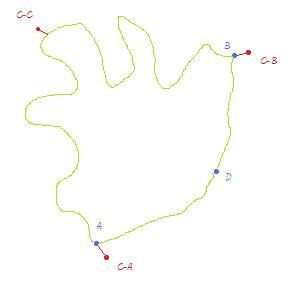I have made a route planning system (based on shortest path using A*) like the Google directions service using pgrouting and google maps. It includes clicking on the map to generate waypoints, dragging of waypoints or polylines to change your desired route. It also shows a directions panel with instructions how to get from A to B.
However in the reverse geocoding i use to find out where the user clicks on the map i return the closest node in the topology. This all works pretty well except for some real world cases where a direct route from A to B is longer than an indirect route through D

The blue A,D,B are the nodes and the red C-A, C-B are my mouse clicks that corresponded to those nodes. The red C-C is the place on the edge where i want my route to visit.
If a user wants to go from A to B through the long direct edge it isn't possible atm because it isn't the fastest route.
I am looking for a way to route over edges or partial edges. One can imagine that a user doesn't want to start in a node but somewhere halfway on an edge (this is another use case but i feel it will be solved as well with the answer i seek).
The cleanest way i can come up with is generating temporary nodes on an edge when a user clicks there (see click C-C on the image) by effectively splitting up an edge into 2 edges and placing a new (temporary) node on the split point. This way pgrouting can route over this new node and thus force the route to follow the edges surrounding that new node.
However, this will generate a lot of temporary nodes when dragging a polyline across the map. All those during_drag_generated nodes have to be removed except the one created at drag_end as that one becomes part of the final route.
So i am wondering are there easier ways to solve this?
